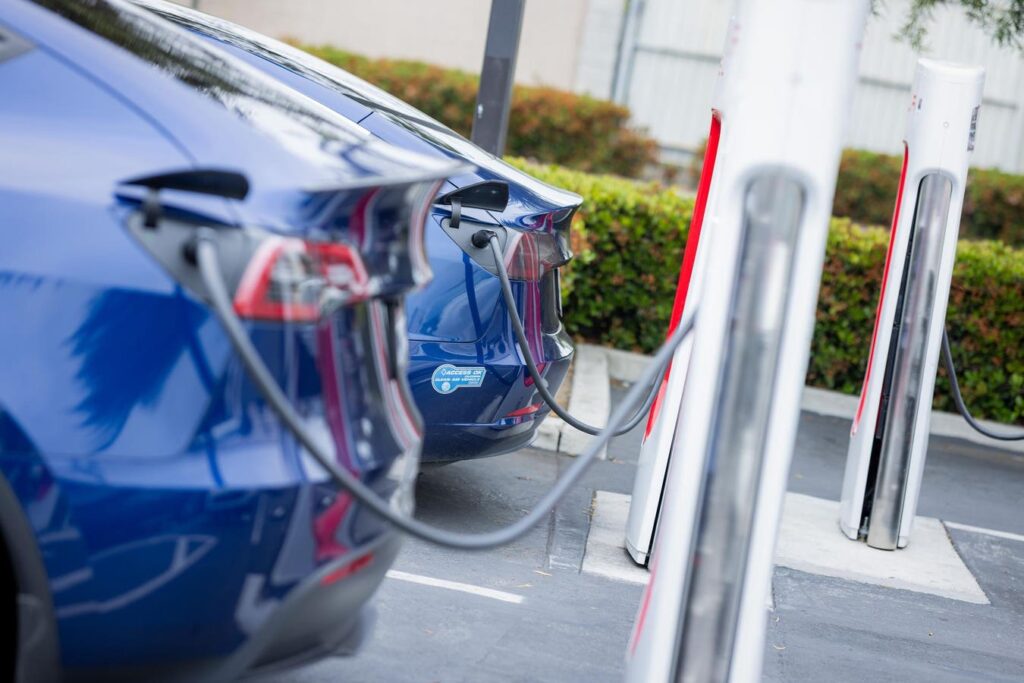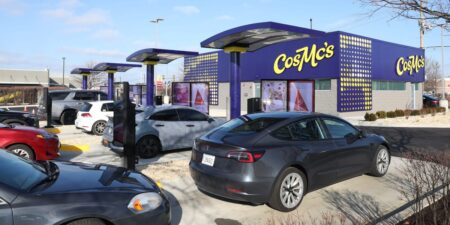What became of Tesla’s (NASDAQ:TSLA) original mission – to catalyze the world’s transition to sustainable energy and reinvent transportation from the ground up? What once sounded like a pipe dream became a bold, stepwise strategy: start with a sports car, use that money to build affordable EVs, and power it all with clean energy. That mattered. It still does. Why?
One number captures it all.
66%
Yes, 66% is the fraction of oil that’s used in transportation. See U.S. Oil Consumption By Sector. Think of that. If all cars ran on electricity, petroleum consumption would collapse by nearly half. The remainder, jet fuel, and harder-to-solve use cases would come soon after. This was always part of Tesla’s original master plan: target the heart of oil demand first. Separately, see how Apple Stock Can Get Back To $250, Even With Tariffs.
This is why Tesla still matters. Electrifying transport isn’t just a cool technology trend – it’s a direct assault on the world’s biggest source of oil consumption. This was step one of what Tesla originally envisioned: “Create a low-volume, expensive car, which would fund development of a medium-volume, lower-cost car” and scale EV adoption in lockstep. While the company’s mission has been bold, the stock has been very volatile. If you are looking for potential upside with less volatility than a single stock, consider the High-Quality portfolio, which has outperformed the S&P 500 and delivered returns exceeding 91% since its inception.
So What?
Look at the two pictures below. Air pollution in the U.S. during Covid-19. That’s the first picture. And the second one is business as usual.
Night and day. It’s as if we’re living in a world shrouded by carbon emissions, and oblivious. But there’s something even simpler: getting close to 100% EV adoption in America is still within Tesla’s reach. Why? Because Tesla has approached the mission the right way – “Don’t tell people – show them.” It demonstrated the viability of EVs, while making them affordable and desirable.
Think: Tesla’s EVs can scale in autos. In the same way, Apple’s iPhones scaled in mobile phones.
Before iPhones, more than 90% of mobile phones were feature phones – yes, they existed. They were everywhere, Motorola Razors, Nokias. They didn’t even have internet browsing.
EVs as a segment can grow to become all autos. But Tesla’s goal wasn’t just to build great cars – it was to show that great cars could be electric. That’s how segments shift . This was always bigger than one company – it was about proving a model others could follow.
Tesla’s Original Mission
Tesla never set out just to make cool cars – it set out to end the era of fossil fuels. The company’s 2006 Master Plan was shockingly simple yet revolutionary:
- Build a high-end sports car to prove EVs could outperform traditional vehicles.
- Use the profits to make progressively more affordable EVs – Model S, then Model 3.
- Provide zero-emission electric power generation options through solar.
- Make everything seamlessly integrated, from the car to your house, so people could generate, store, and consume clean energy themselves.
The mission was designed around energy efficiency. EVs convert nearly 90% of electrical energy into motion, while internal combustion engines waste a huge chunk of fuel energy as heat and friction. That’s not marginal – it’s transformative. Even when charged from natural gas power plants, EVs still beat gasoline cars in efficiency and emissions.
And this doesn’t even account for Tesla’s ability to run on renewable electricity. Solar and Nuclear – none of these emit CO₂. So as the grid gets cleaner, EVs get cleaner too. Gasoline cars? They stay dirty forever. And Tesla knew this synergy. That’s why it didn’t stop at the vehicle – it built rooftop solar and Powerwall home batteries as part of a clean, closed-loop energy ecosystem.
Tesla even opened its patents to competitors because the goal wasn’t monopoly. It was systemic change. That strategy worked. EVs are no longer punchlines – they’re surging. But Tesla’s mission risks unraveling – not because the goal was flawed, but because the focus has frayed. What began as an all-encompassing energy transition has narrowed into price wars, branding stumbles, and politicized noise.
So What Happened?
It’s happening in China! Roughly 40% of all vehicles sold in China in Q1 2025 were EVs or plug-in hybrids. Tesla, however, is losing ground. Its deliveries in China fell 8% in April, even as the broader EV market grew. Local champions like BYD are producing more vehicles, with more tech, at lower prices. But not in America, where it all started. Where did we lose our edge? Our advantage? Our purpose?
Tesla’s U.S. market share is also slipping. Despite a record Q1 for EVs overall in the U.S., Tesla’s share of the U.S. auto market fell to just 3%, down from highs of about 5%. That’s not just market dynamics – it’s a brand under pressure.
Part of the reason for brand slippage is Elon Musk himself. His political endorsements and polarizing behavior have turned off parts of Tesla’s core audience. In Europe, Tesla’s April sales plunged – down 62% in the UK, 67% in Denmark, 74% in the Netherlands, and 59% in France – even as EV adoption rose in these countries.
Cheap gas isn’t helping either. U.S. crude prices have dropped below $60 a barrel, meaning that gas vehicles are getting cheaper to run. That undercuts one of the stronger economic cases for going electric. Combine that with a mixed economy, and many customers could start delaying upgrades.
Now Musk is back from DOGE business, maybe he’ll remember Tesla’s bigger energy cause. Growing Tesla from 2 million cars to 20 million cars sold annually is good – good for the environment, good for Tesla, and good for Elon Musk’s wealth! Volume brings cost parity. Cost parity brings mass adoption. The master plan wasn’t just a memo – it was the business model.
There are some tailwinds Tesla could ride on. Trump’s tariffs on vehicles could give Tesla an edge due to its sizable domestic manufacturing. A friendly regulatory setup could help Tesla push its autonomous driving features faster to market, giving it a lead over rivals. And don’t forget, autonomy was a quietly embedded goal in Tesla’s original plan too—reduce accidents, improve utilization, and lower the cost per mile for everyone. With measurable and meaningful metrics like that, there is no reason why Tesla can’t be steered in the direction we all want to see. See: Should Tesla Still Be Valued Like a Growth Stock?
For investors aiming to reduce the inherent volatility associated with individual stocks like Tesla, there are alternative investment strategies available. The Trefis RV strategy, which has a history of outperforming its all-cap stock benchmark, provides a diversified approach to potentially achieve solid returns. Likewise, the High-Quality portfolio has shown superior performance compared to the S&P 500 with returns that exceed 91% since its initiation, offering potential upside with reduced stock-specific risk.
Read the full article here
















